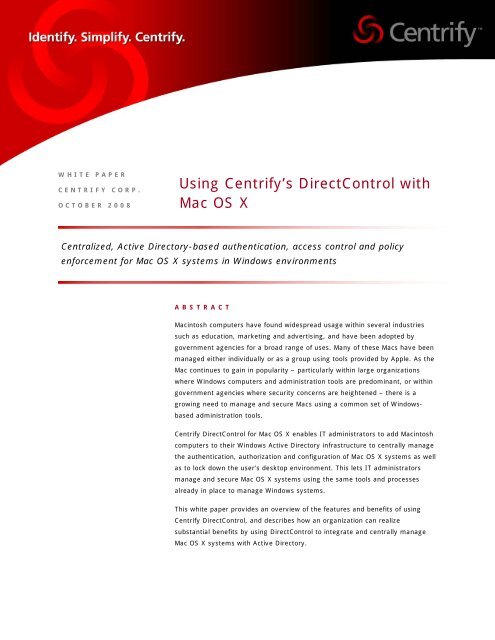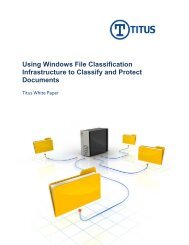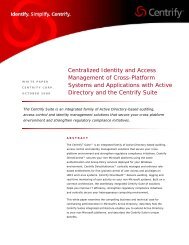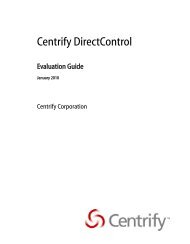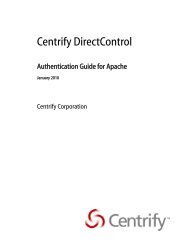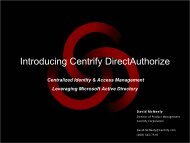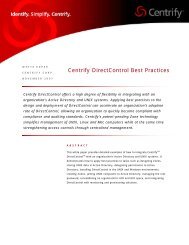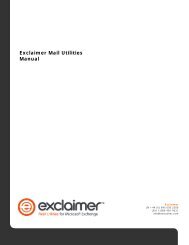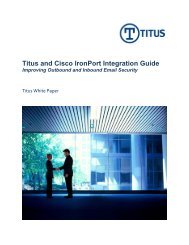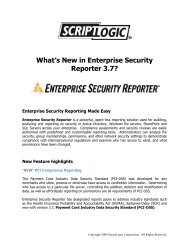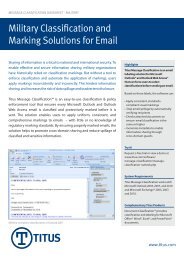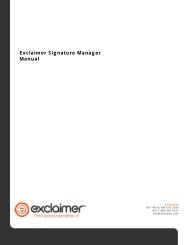Using Centrify's DirectControl with Mac OS X - Cerberis
Using Centrify's DirectControl with Mac OS X - Cerberis
Using Centrify's DirectControl with Mac OS X - Cerberis
You also want an ePaper? Increase the reach of your titles
YUMPU automatically turns print PDFs into web optimized ePapers that Google loves.
WHITE PAPERCENTRIFY CORP.OCTOBER 2008<strong>Using</strong> Centrify’s <strong>DirectControl</strong> <strong>with</strong><strong>Mac</strong> <strong>OS</strong> XCentralized, Active Directory-based authentication, access control and policyenforcement for <strong>Mac</strong> <strong>OS</strong> X systems in Windows environmentsABSTRACT<strong>Mac</strong>intosh computers have found widespread usage <strong>with</strong>in several industriessuch as education, marketing and advertising, and have been adopted bygovernment agencies for a broad range of uses. Many of these <strong>Mac</strong>s have beenmanaged either individually or as a group using tools provided by Apple. As the<strong>Mac</strong> continues to gain in popularity – particularly <strong>with</strong>in large organizationswhere Windows computers and administration tools are predominant, or <strong>with</strong>ingovernment agencies where security concerns are heightened – there is agrowing need to manage and secure <strong>Mac</strong>s using a common set of Windowsbasedadministration tools.Centrify <strong>DirectControl</strong> for <strong>Mac</strong> <strong>OS</strong> X enables IT administrators to add <strong>Mac</strong>intoshcomputers to their Windows Active Directory infrastructure to centrally managethe authentication, authorization and configuration of <strong>Mac</strong> <strong>OS</strong> X systems as wellas to lock down the user’s desktop environment. This lets IT administratorsmanage and secure <strong>Mac</strong> <strong>OS</strong> X systems using the same tools and processesalready in place to manage Windows systems.This white paper provides an overview of the features and benefits of usingCentrify <strong>DirectControl</strong>, and describes how an organization can realizesubstantial benefits by using <strong>DirectControl</strong> to integrate and centrally manage<strong>Mac</strong> <strong>OS</strong> X systems <strong>with</strong> Active Directory.
CENTRIFY WHITE PAPERUSING CENTRIFY’S DIRECTCONTROL WITH MAC <strong>OS</strong> XInformation in this document, including URL and other Internet Web site references, is subject to change<strong>with</strong>out notice. Unless otherwise noted, the example companies, organizations, products, domain names, e-mailaddresses, logos, people, places and events depicted herein are fictitious, and no association <strong>with</strong> any realcompany, organization, product, domain name, e-mail address, logo, person, place or event is intended orshould be inferred. Complying <strong>with</strong> all applicable copyright laws is the responsibility of the user. Withoutlimiting the rights under copyright, no part of this document may be reproduced, stored in or introduced into aretrieval system, or transmitted in any form or by any means (electronic, mechanical, photocopying, recording,or otherwise), or for any purpose, <strong>with</strong>out the express written permission of Centrify Corporation.Centrify may have patents, patent applications, trademarks, copyrights, or other intellectual property rightscovering subject matter in this document. Except as expressly provided in any written license agreement fromCentrify, the furnishing of this document does not give you any license to these patents, trademarks, copyrights,or other intellectual property.© 2006-2008 Centrify Corporation. All rights reserved.Centrify and <strong>DirectControl</strong> are trademarks of Centrify Corporation in the United States and/or other countries.Microsoft, Active Directory, Windows, Windows NT, and Windows Server are either registered trademarks ortrademarks of Microsoft Corporation in the United States and/or other countries.The names of actual companies and products mentioned herein may be the trademarks of their respectiveowners.[WP009-2008-10-21]© 2006-2008 CENTRIFY CORPORATION. ALL RIGHTS RESERVED. PAGE II
CENTRIFY WHITE PAPERUSING CENTRIFY’S DIRECTCONTROL WITH MAC <strong>OS</strong> XContents1 Introduction ................................................................................................ 11.1 IT Support Challenges for <strong>Mac</strong> <strong>OS</strong> X in the Enterprise ................................... 11.2 <strong>DirectControl</strong> Provides the Tools Required for IT to Support <strong>Mac</strong> <strong>OS</strong> X ............ 21.3 Centrify and the Enterprise Desktop Alliance................................................ 32 Active Directory Authentication and Access Control for <strong>Mac</strong> <strong>OS</strong> X ............... 32.1 Active Directory User Authentication <strong>with</strong> <strong>DirectControl</strong>................................. 52.2 User Account and Administration Considerations <strong>with</strong> <strong>DirectControl</strong> ................ 82.3 Key Differences between <strong>DirectControl</strong> and Apple’s Active Directory Plug-in .. 103 Centralized Configuration and Policy Management for <strong>Mac</strong> <strong>OS</strong> X ............... 113.1 <strong>DirectControl</strong> Group Policy Enforcement on <strong>Mac</strong> <strong>OS</strong> X ................................. 113.2 Common UNIX Group Policies for <strong>Mac</strong> <strong>OS</strong> X ............................................... 123.3 Computer Group Policies for <strong>Mac</strong> <strong>OS</strong> X ...................................................... 133.4 User Group Policies for <strong>Mac</strong> <strong>OS</strong> X ............................................................. 164 Streamlined Deployment: Workstation Mode and Automated Installation. 215 Strong Authentication and Single Sign-on through Smart Card Login toActive Directory......................................................................................... 236 Customer Benefits of the Centrify <strong>DirectControl</strong> Solution .......................... 267 Summary ................................................................................................... 278 How to Contact Centrify ............................................................................ 28© 2006-2008 CENTRIFY CORPORATION. ALL RIGHTS RESERVED. PAGE III
CENTRIFY WHITE PAPERUSING CENTRIFY’S DIRECTCONTROL WITH MAC <strong>OS</strong> X1 IntroductionMost organizations have standardized on Windows computers. However, <strong>Mac</strong>intoshcomputers are becoming increasingly popular in a number of different areas. Where theywere once relegated to educational organizations or specific departments <strong>with</strong>in largeorganizations, they are now seen breaking out of the traditional roles of the creativemarketing and advertising groups into the general computer population. However, manyof these organizations have never truly seen these <strong>Mac</strong>s as part of their global ITinfrastructure. It is very common to see <strong>Mac</strong> <strong>OS</strong> X systems flying “under the radar” asstandalone systems <strong>with</strong>out any oversight from a central IT organization.1.1 IT Support Challenges for <strong>Mac</strong> <strong>OS</strong> X in the EnterpriseIn the past, <strong>Mac</strong>intosh users have typically acquired their own systems and were expectedto support themselves or even work together <strong>with</strong>in their own departments to supporteach other. Apple has focused their Windows and Active Directory integration serviceson providing tools that enable the <strong>Mac</strong>intosh owner or group administrator to plug intothese Windows-centric networks themselves, enabling Active Directory-basedauthentication and providing seamless access to Windows services using <strong>Mac</strong>intoshcentricadministrative tools. However, the configuration of these integration tools ismanaged locally on the individual <strong>Mac</strong>intosh system and does not lend itself to the typeof mass deployment or centralized administration most enterprise IT departments expect.And although <strong>Mac</strong> <strong>OS</strong> X systems can be configured <strong>with</strong> <strong>Mac</strong>intosh-centric tools andservices such as Apple Workgroup Manager, this requires you to set up a <strong>Mac</strong>management infrastructure using Apple’s Open Directory Server that is independent andparallel to your Windows management infrastructure. This is a very typical configurationcalled the golden triangle, where authentication is performed by Active Directory andcentralized configuration management is handled by Open Directory and WorkgroupManager.While the golden triangle configuration will work to provide basic integration, it stillleaves the <strong>Mac</strong>intosh community <strong>with</strong>in the enterprise to support themselves. The realproblem is that the IT staff spends the majority of their time supporting the Windowsnetwork, and they simply do not have the time to learn a new set of tools, nor do theyhave proper tools to manage or support <strong>Mac</strong>intosh systems <strong>with</strong>in their Windows centricenvironment. Consequently, they have left these groups of <strong>Mac</strong>intosh users to manageand support their own systems. This lack of support and integration into the enterpriseresults in several problems that face the typical <strong>Mac</strong>intosh user:• IT staff do not have the tools or abilities to provide support and resolve problems on<strong>Mac</strong>intosh systems.• Security policies are not enforced consistently on <strong>Mac</strong>intosh systems.• Common services are simply not supported or provided to <strong>Mac</strong>intosh users.© 2006-2008 CENTRIFY CORPORATION. ALL RIGHTS RESERVED. 1
CENTRIFY WHITE PAPERUSING CENTRIFY’S DIRECTCONTROL WITH MAC <strong>OS</strong> XSeveral factors are driving the need <strong>with</strong>in IT to centralize authentication, authorizationand support services as well as configuration management. IT must address regulatorycompliance requirements across the organization, improve service levels, and enhanceefficiency for both itself and end-users. Given these drivers, IT needs tools that enablethem to provide a consistent level of service to all users regardless of the type ofcomputer they use, preferably administering <strong>with</strong> the same tools that they use today<strong>with</strong>out having to learn a new tool set.Although government and industry regulations are typically focused on systems whereconfidential customer or business data is stored, organizations in highly regulatedindustries or governmental agencies have an interest in ensuring best practices aroundsecure and responsible use of personal workstations. Barriers to <strong>Mac</strong>intosh adoption maybe lowered in these organizations if IT security managers can be assured they have thetools at hand to lockdown the <strong>Mac</strong> desktop; for example, to require smart card-based login, to prevent mounting of external storage devices, to disable the ability to createunsecured wireless networks, to limit access to applications, and to define theconfiguration of applications.1.2 <strong>DirectControl</strong> Provides the Tools Required for IT to Support <strong>Mac</strong><strong>OS</strong> X<strong>DirectControl</strong> for <strong>Mac</strong> <strong>OS</strong> X enables IT to integrate <strong>Mac</strong>intosh systems into ActiveDirectory and provide the level of support that these users require. <strong>DirectControl</strong>provides Active Directory-based authentication services as well as Group Policyenforcement leveraging the same administrative tools that IT currently uses to manageWindows systems. <strong>DirectControl</strong> authentication services are designed to integrate the<strong>Mac</strong>intosh computer into Active Directory to provide authentication and login policyenforcement exactly like a Windows computer that is joined to Active Directory. GroupPolicy enforcement is also provided for both a) computer policies on the system to enablecentralized management of the System Preferences configuration and b) user policies toenable centralized desktop configuration lockdown and application access controls on the<strong>Mac</strong>intosh systems. <strong>DirectControl</strong> also supports smart card-based login.For large organizations, <strong>DirectControl</strong> provides the granular access controls anddelegated administration features they need to manage logical groups of <strong>Mac</strong> systemsseparately. <strong>Using</strong> <strong>DirectControl</strong>’s unique Zone technology, IT administrators can creategroups of <strong>Mac</strong> systems that have their own set of users, administrators, and policies.Centrify also enables quick deployment of <strong>DirectControl</strong> through an automatedinstallation program and a workstation mode that joins <strong>Mac</strong>s to Active Directoryimmediately <strong>with</strong>out the need for any additional setup sets.© 2006-2008 CENTRIFY CORPORATION. ALL RIGHTS RESERVED. 2
CENTRIFY WHITE PAPERUSING CENTRIFY’S DIRECTCONTROL WITH MAC <strong>OS</strong> X1.3 Centrify and the Enterprise Desktop AllianceAs Centrify worked <strong>with</strong> large organizations todefine requirements for <strong>Mac</strong> integration <strong>with</strong>ina Windows-centric IT environment, customersfrequently also asked questions regardingadditional services that would further easedeployment and management of <strong>Mac</strong>s. As a result, Centrify decided to spearhead thecreation of the Enterprise Desktop Alliance (EDA), a consortium of <strong>Mac</strong>intosh vendorsthat are delivering enterprise-class software solutions for <strong>Mac</strong> integration andinteroperability <strong>with</strong> Windows environments. Along <strong>with</strong> Centrify’s identity and accessmanagement solution for the <strong>Mac</strong>, the EDA partners also offer solutions for systemslifecycle management, enterprise data protection, file and print services, andvirtualization. The EDA’s web site provides a wide range of white papers to helpcustomers research solutions, and the organization is sponsoring a series of onlinewebinars demonstrating how their solutions can be used in tandem to lower barriers toacceptance of <strong>Mac</strong>s <strong>with</strong>in the enterprise..The following sections describe the services provided by <strong>DirectControl</strong>, explain how<strong>DirectControl</strong> differs from Apple’s management tools, and details the unique features andbenefits of using <strong>DirectControl</strong> to manage populations of <strong>Mac</strong>intosh computers, bothlarge and small.2 Active Directory Authentication and Access Control for <strong>Mac</strong> <strong>OS</strong> XWhile every <strong>Mac</strong> <strong>OS</strong> X system that Apple ships comes <strong>with</strong> a built-in repository for userand group information stored in a local NetInfo database, any time there is more than one<strong>Mac</strong> <strong>OS</strong> X system in a network where the users will need to either access sharedresources or log in to other systems, it is best to configure a directory service to centrallymanage these accounts, making them available to all the systems in the network. Appleprovides many different options for configuring a network-based directory service, fromplug-ins that allow usage of existing LDAP directories to their own Open Directoryserver. Apple also delivers an Active Directory plug-in that provides the basic functionsof establishing a trusted relationship between the computer and Active Directory, whichenables Active Directory user accounts to be used for login to the <strong>Mac</strong> <strong>OS</strong> X system.However, this plug-in requires local configuration to define how the user’s UID and GIDwill be defined based on their Active Directory account; in most cases it is configured toautomatically generate UIDs and GIDs for Active Directory users logging into thesystem. While this may be acceptable for smaller deployments where the configurationcan be manually set for each system, it does not scale well for deployment in largerenvironments <strong>with</strong> larger numbers of <strong>Mac</strong> <strong>OS</strong> X systems.© 2006-2008 CENTRIFY CORPORATION. ALL RIGHTS RESERVED. 3
CENTRIFY WHITE PAPERUSING CENTRIFY’S DIRECTCONTROL WITH MAC <strong>OS</strong> XThere are several key differences between <strong>DirectControl</strong> and the Active Directory plug-inthat Apple provides <strong>with</strong> <strong>Mac</strong> <strong>OS</strong> X for authentication, such as centralized administrativecontrol over the user’s underlying Unix UID and GID assignment as well as the granularaccess controls which are centrally managed <strong>with</strong>in Active Directory. <strong>DirectControl</strong> isdesigned as a complete Active Directory client for non-Windows systems, including the<strong>Mac</strong> <strong>OS</strong> X platform, making it a direct replacement for the Apple <strong>Mac</strong> <strong>OS</strong> X ActiveDirectory plug-in. All administration of user accounts, password policies and securitypolicies are managed using Active Directory administrative tools, including ActiveDirectory Users and Computers, the Group Policy Management Console, and the GroupPolicy Object Editor as well as the Centrify <strong>DirectControl</strong> Administrative Console.© 2006-2008 CENTRIFY CORPORATION. ALL RIGHTS RESERVED. 4
CENTRIFY WHITE PAPERUSING CENTRIFY’S DIRECTCONTROL WITH MAC <strong>OS</strong> X2.1 Active Directory User Authentication <strong>with</strong> <strong>DirectControl</strong><strong>DirectControl</strong> for <strong>Mac</strong> <strong>OS</strong> X consists of two main architectural components.<strong>DirectControl</strong> for Systems<strong>DirectControl</strong> for Systems<strong>DirectControl</strong> for ApplicationsWindows Computer<strong>DirectControl</strong> for SystemsMicrosoft Active Directory+ Centrify <strong>DirectControl</strong><strong>DirectControl</strong>Management ToolsAdministratorFigure 1. Components of the <strong>DirectControl</strong> Suite.• On the <strong>Mac</strong>intosh platform, a <strong>DirectControl</strong> Agent is installed on each server orworkstation. The <strong>DirectControl</strong> Agent is not just a directory service plug-in; rather, itis a central service that provides both authentication and authorization services aswell as Group Policy enforcement. The Agent also determines which <strong>DirectControl</strong>enabledusers can log in to the system or network services using their ActiveDirectory credentials.• On the Windows platform, the optional <strong>DirectControl</strong> Management Tools can beinstalled on one or more Windows computers in the domain. These tools include theCentrify Administrator Console, property extensions to Active Directory Users andComputers, and a web-based Administrator’s Console. If you are deploying<strong>DirectControl</strong> in workstation mode, it is not strictly required to install these tools.However, most organizations will want to use the management tools to implement© 2006-2008 CENTRIFY CORPORATION. ALL RIGHTS RESERVED. 5
CENTRIFY WHITE PAPERUSING CENTRIFY’S DIRECTCONTROL WITH MAC <strong>OS</strong> XGroup Policy on their <strong>Mac</strong> systems and to run the administrative reports. Themanagement tools are required if you decide to implement the advanced accesscontrols and delegated administration features provided by <strong>DirectControl</strong> Zones..The optional <strong>DirectControl</strong> Management Tools are the only Windows software you mightneed. You are not required to install software on your Windows domain controllers, and<strong>DirectControl</strong> installation never requires modifications to your Active Directory schema.If you choose to use Zone-based access controls, as <strong>Mac</strong>intosh users and computers joinyour Active Directory domain, the Centrify <strong>DirectControl</strong> Agent unobtrusively stores itsdata in an Active Directory program data container using a standardized method. Centrify<strong>DirectControl</strong> also works seamlessly and unobtrusively <strong>with</strong> Active Directory if you havepreviously installed Microsoft Services for UNIX (SFU), which applies its own schemachanges to Active Directory to store UNIX attributes for user accounts. <strong>DirectControl</strong>also works <strong>with</strong> Microsoft’s UNIX schema extensions that are included in WindowsServer 2003 R2.The <strong>DirectControl</strong> Agent in effect turns the <strong>Mac</strong> <strong>OS</strong> X system into an Active Directoryclient. The Agent enables the <strong>Mac</strong> client to consume and respond to Active Directoryservices in the same way a Windows client does.Login Apps(login, ftp, ssh, etc.)KerberizedApps(ssh, SMB etc.)SystemConfig FilesDirectory PluginServiceKerberosLibrariesGroup PolicyModuleOfflineCredentialCacheCLIAdminTools<strong>DirectControl</strong> Daemon(adclient)Centrify <strong>DirectControl</strong> AgentWindows DomainControllersMicrosoftActive DirectoryFigure 2. Architecture of the <strong>DirectControl</strong> for <strong>Mac</strong> <strong>OS</strong> X AgentThe <strong>DirectControl</strong> Agent is responsible for the following functions in order to provide asecure authentication framework for integrating <strong>Mac</strong> <strong>OS</strong> X into Active Directory.• Enables the <strong>Mac</strong>intosh computer to join an Active Directory domain. Once the<strong>Mac</strong>intosh system has been joined to the Active Directory domain, it is visible as astandard computer object in the Active Directory Users and Computers console.© 2006-2008 CENTRIFY CORPORATION. ALL RIGHTS RESERVED. 6
CENTRIFY WHITE PAPERUSING CENTRIFY’S DIRECTCONTROL WITH MAC <strong>OS</strong> X• Locates the relevant domain controllers based on the Active Directory forest and sitetopology, also known as being site-aware.• Maintains time synchronization <strong>with</strong> Active Directory domain controllers if desired.• Maintains an MIT-based Kerberos environment so that existing Kerberosapplications will work seamlessly <strong>with</strong> Active Directory to provide users <strong>with</strong> singlesign-on access to network resources such as Windows file servers and print queues.• Ensures network security by resetting the password on its machine account at regularintervals according to Active Directory domain policies.• Enables logins using users’ Active Directory credentials. Logging on in this contextmeans not only logging into the <strong>Mac</strong> <strong>OS</strong> X graphic interface, but also connecting tothe <strong>Mac</strong>intosh through a remote SSH or Apple Remote Desktop interface.• Enables authentication <strong>with</strong> smart cards, including PIV, CAC and .Net cards.• Updates a user’s last login time upon Active Directory login to ensure that passwordexpiration policies are being enforced properly.• Stores user credentials and profiles so that users can log on when the computer isdisconnected from the network, which is especially useful for laptop computers<strong>with</strong>out requiring a locally defined mobile user.• Caches responses from Active Directory information queries to reduce the load onthe domain controllers.• Validates that the user has appropriate permissions to log in to the <strong>Mac</strong>intosh systembased on account policies. For example, Active Directory provides a set of accountspecificcontrols enabling the administrator to activate or disable a user’s ActiveDirectory account as well as to control the time of day the user is allowed to log in.• When the <strong>Mac</strong> is a member of a <strong>DirectControl</strong> Zone, validates that the user hasappropriate permissions to log in based on Zone memberships and allowed groupmembership.• Determines a user’s full UNIX-enabled Active Directory group membership(including nested groups) the first time the user logs on.• Supports users managing their Active Directory passwords from <strong>Mac</strong>intosh systemsboth for the ad hoc password change as well as for expired password at login.• Validates privileged account logins centrally from Active Directory when needed<strong>with</strong>out requiring previously defined local administrator accounts.• Dynamically creates home directories locally on the computer for users whoseprofile defines a local home directory path. <strong>DirectControl</strong> also supports seamlesslymounting network-based home directories from Windows servers or AFP servers as© 2006-2008 CENTRIFY CORPORATION. ALL RIGHTS RESERVED. 7
CENTRIFY WHITE PAPERUSING CENTRIFY’S DIRECTCONTROL WITH MAC <strong>OS</strong> Xwell as providing the option to define a locally synchronized version of the networkhome directory for laptop users.• Enforces user Group Policies that control the user’s desktop experience such asapplication access control and dock settings as well as to control the user’s ability toexecute privileged operations.• Provides authenticated single sign-on access to Windows print queues using theuser’s Active Directory credentials to ensure proper access and accounting for useraccess to printers.2.2 User Account and Administration Considerations <strong>with</strong><strong>DirectControl</strong>Many organizations will have more than one grouping of computer systems that are usedfor a specific purpose, and typically it is neither desirable nor practical to allow all usersin an enterprise to log on to any system. To deal <strong>with</strong> this, Centrify has developed theconcept of Zones to create a way of grouping systems in order to provide fine-grainedaccess controls and delegated administration. In addition to using Zones for accesscontrol, organizations <strong>with</strong> a diverse environment of UNIX, Linux and <strong>Mac</strong> systems alsohave the option of using Zones to avoid collisions in user IDs and group IDs. Although<strong>Mac</strong> end-users rarely also need login privileges on UNIX or Linux systems, ITadministrators will want to read this section for the complete picture of how Zones work<strong>with</strong>in a large, mixed environment. Keep in mind in this section that Zones are notavailable for <strong>Mac</strong>s that were added to Active Directory using <strong>DirectControl</strong>’s workstationmode.Figure 3. Example of an Enterprise Organized into Departmental ZonesThe <strong>DirectControl</strong> Zone technology, as shown in the illustration above, works like this:© 2006-2008 CENTRIFY CORPORATION. ALL RIGHTS RESERVED. 8
CENTRIFY WHITE PAPERUSING CENTRIFY’S DIRECTCONTROL WITH MAC <strong>OS</strong> X• Each <strong>DirectControl</strong>-managed UNIX, Linux or <strong>Mac</strong> system can be placed into a<strong>DirectControl</strong> Zone, typically directly mapping to an existing logical securityboundary or administrative grouping such an organizational department or lab.• A user (Joan Smith in Figure 3) is configured in Active Directory <strong>with</strong> her normalWindows information, such as name, password, group membership and so on. Inaddition, the “Centrify Profiles” that Centrify adds to her Active Directory accountindicates which Zones she can access.• For each Zone, Joan’s UNIX/<strong>Mac</strong> profile in Active Directory stores accountinformation specific to that Zone: UNIX user name, user ID, shell, and homedirectory for example. Thus, a single Active Directory account can be mapped to anynumber of UNIX/<strong>Mac</strong> identities.• Joan can log in to computers only in the Zones to which she has been granted access.Whereas Joan has access to several Zones, another user – for example, a student in auniversity setting – could be given rights to access only <strong>Mac</strong>s in a Zone set up for aclassroom lab, and not be given access to <strong>Mac</strong>s or other systems in Zones set up forcomputers used in administrative or research departments.• As Figure 3 illustrates, Joan authenticates through Active Directory regardless ofwhich system she logs in to. The Zones are part of the same Active Directory domainwhere Joan’s account exists.Delegation and separation of duties is a critical component of any centralizedadministration solution where security is a concern. <strong>DirectControl</strong> Zones provide anenvironment <strong>with</strong> Active Directory that leverages native access control rules <strong>with</strong>inActive Directory to delegate UNIX profile management as well as UNIX/<strong>Mac</strong> systemaccess rights management to UNIX administrators <strong>with</strong>out requiring domainadministrator rights. With <strong>DirectControl</strong>, UNIX and <strong>Mac</strong> administrators do not needrights to modify or create user objects, which is typically a privileged operation <strong>with</strong>inthe enterprise.Additionally, each Zone can have its own set of administrators, each <strong>with</strong> specificprivileges <strong>with</strong>in the Zone. In our university example, Joan may be an IT administratorwho has the right to create and modify user accounts in Active Directory for students andemployees, and the right to create Zones and add users to Zones. However, a graduatestudent who runs a <strong>Mac</strong>intosh lab could be given rights only to add or remove existinguser accounts to the <strong>Mac</strong> lab Zone. This added security feature means not only can usersand computers be compartmentalized into logical secure groups, but the administratorswho manage those systems can also be segregated. For many organizations, the ability tofinely control the elevated privileges for administrators is essential for maintainingappropriate levels of confidentiality and for complying <strong>with</strong> regulatory controls.© 2006-2008 CENTRIFY CORPORATION. ALL RIGHTS RESERVED. 9
CENTRIFY WHITE PAPERUSING CENTRIFY’S DIRECTCONTROL WITH MAC <strong>OS</strong> X2.3 Key Differences between <strong>DirectControl</strong> and Apple’s ActiveDirectory Plug-in<strong>DirectControl</strong> is designed to provide what seems on the surface as an equivalent solutionto the Active Directory plug-in that Apple provides <strong>with</strong> <strong>Mac</strong> <strong>OS</strong> X out of the box;however, there are several key differences between the solutions. Fundamentally,<strong>DirectControl</strong> is designed to provide the centralized administration staff <strong>with</strong> the toolsrequired to centrally manage heterogeneous computing environments from existingWindows administrative tools. Here are some of the key differences:• <strong>DirectControl</strong> provides consistent Active Directory integration across multipleplatforms. <strong>DirectControl</strong> provides a single integration solution not only for <strong>Mac</strong> <strong>OS</strong>X but for popular UNIX and Linux platforms as well.• <strong>DirectControl</strong> Zones can be used to further control user access as well as to segregatethe <strong>Mac</strong>intosh user population and administrative staff and keep their rights at aminimum <strong>with</strong>in Active Directory.• Offline login is provided <strong>with</strong> locally cached account profiles for users <strong>with</strong> localhome directories. However, if the user has a network home directory he will beprompted to create a mobile account to take advantage of the synchronizationbetween the local and network-based home directories.• <strong>DirectControl</strong> enables common account administration of both Windows and<strong>Mac</strong>intosh systems leveraging tools such as Active Directory Users and Computers.• UID and GID assignment is managed centrally <strong>with</strong>in Active Directory as additionalattribute information about these objects versus a local configuration <strong>with</strong>in theDirectory Services configuration interfaces.• There are many security-related benefits to using <strong>DirectControl</strong> for Active Directoryintegration. For example, the machine account password is periodically changed, allcommunications to Active Directory are Kerberized, and user access to Windowsprint queues is authenticated in a single sign-on fashion.• <strong>DirectControl</strong> provides a reporting facility to enable generation of several reports onActive Directory information such as computer access reports.• <strong>DirectControl</strong> provides delegated administration <strong>with</strong> separation of duties betweenActive Directory and <strong>Mac</strong>intosh administrators as well as between groups of<strong>Mac</strong>intosh administrators.Additionally, the <strong>DirectControl</strong> Agent that provides user authentication and authorizationservices also provides Group Policy enforcement to enable centralized configurationmanagement. Centralized configuration and Group Policy services are described in moredetail in the next section.© 2006-2008 CENTRIFY CORPORATION. ALL RIGHTS RESERVED. 10
CENTRIFY WHITE PAPERUSING CENTRIFY’S DIRECTCONTROL WITH MAC <strong>OS</strong> X3 Centralized Configuration and Policy Management for <strong>Mac</strong> <strong>OS</strong> XConfiguration management and policy enforcement across an enterprise is extremelyimportant to most organizations, especially if there is a need to ensure that securitypolicies are properly enforced across all computers. Additionally there are severalbenefits to centralizing the configuration of workstations and servers, including:• Reducing the effort required to bring a new computer into the environment,configuring it properly and ensuring that it stays configured properly throughout itslifecycle, resulting in a much lower total cost of ownership.• Ensuring that security policies are properly enforced across the enterprise to ensurethat no holes exist for potential attackers to exploit.• Automatically configuring the user environment so that all users have a consistentcomputing experience that provides them the services they need to accomplish theirwork.Apple provides a tool to centrally manage the configuration and security policies of <strong>Mac</strong><strong>OS</strong> X computers. However, this tool, Workgroup Manager, requires either a set ofschema modifications to Active Directory in order to integrate or a separate OpenDirectory deployment in order to provide centralized management. However, inWindows environments, most administrators use Group Policy to centrally configureWindows workstations to enforce consistent security policies as well as to ensure aconsistent end-user experience across all workstations deployed <strong>with</strong>in the environment.<strong>DirectControl</strong> provides broad and robust support for Group Policy on the <strong>Mac</strong>. ITadministrators thus have a single tool to configure and enforce consistent security policiesto all non-Windows computers, including <strong>Mac</strong> <strong>OS</strong> X systems. <strong>DirectControl</strong> also enablesIT administrators to configure and secure their <strong>Mac</strong> environment through Group Policy<strong>with</strong>out having detailed knowledge of <strong>Mac</strong> desktop configuration. In environments whereworkstation security is particularly important, giving IT security administrators the abilityto lockdown <strong>Mac</strong> workstations through Group Policy can help lower barriers toadoption..3.1 <strong>DirectControl</strong> Group Policy Enforcement on <strong>Mac</strong> <strong>OS</strong> XWindows Group Policy works by forcibly setting user and computer registry keys onWindows machines, and since almost all of a Windows system is configured throughregistry settings, this is a very natural and simple way to enforce almost any policy.However, in UNIX and <strong>Mac</strong> environments there is no equivalent to the Windowsregistry. The de-facto standard for configuration is ASCII text files. To deliver ActiveDirectory’s Group Policy capabilities in UNIX and <strong>Mac</strong> environments, <strong>DirectControl</strong>creates a “virtual registry” of the policies that apply to either the computer itself or tp theusers who log in to the system.The enforcement of these virtual registry settings is handled by two different mechanismsdepending on the service or configuration that needs to be controlled. For applications© 2006-2008 CENTRIFY CORPORATION. ALL RIGHTS RESERVED. 11
CENTRIFY WHITE PAPERUSING CENTRIFY’S DIRECTCONTROL WITH MAC <strong>OS</strong> Xthat use a configuration file to manage their settings, <strong>DirectControl</strong> provides a specificmapper program that knows what needs to be set in the configuration file or, on<strong>Mac</strong>intosh systems, in the plist file for the application associated <strong>with</strong> the particularvirtual registry setting. Additionally, many of the System Preference settings and userenvironment controls are provided by the MCX subsystem <strong>with</strong>in <strong>Mac</strong> <strong>OS</strong> X. Several of<strong>DirectControl</strong>’s the user Group Policies are enforced through the MCX subsystem.The <strong>DirectControl</strong> Agent first must update the Group Policy settings into its virtualregistry based on the computer account or the user who is logged in to the system. Thisload event is triggered by:• System startup. When the <strong>DirectControl</strong> daemon starts up (usually when the systemboots up), it updates the computer’s registry.• User log on. When a user logs on, the <strong>DirectControl</strong> Agent creates or updates theuser’s registry settings.• adgpupdate command. The <strong>DirectControl</strong> Agent can be forced to immediatelyupdate the user and computer registries through this command line.• Periodic refresh interval. The <strong>DirectControl</strong> Agent will also refresh the virtualregistry on a periodic basis according to the Group Policy refresh interval setting inthe domain policy.The loading of policy is asynchronous, which is equivalent to the behavior in recentWindows versions. The loaded settings are stored on the local machine for disconnectedoperation. Once the virtual registry has been updated through one of the events describedabove, then either the appropriate mapper program is activated to update or create theconfiguration or plist file, or the appropriate MCX setting is defined for the application orSystem Preference being controlled.3.2 Common UNIX Group Policies for <strong>Mac</strong> <strong>OS</strong> XCentrify includes a set of Active Directory Group Policies that are common to UNIX,Linux and <strong>Mac</strong> <strong>OS</strong> X platforms that can be applied to users or systems, as appropriate.<strong>DirectControl</strong> includes more Group Policy objects than any other solution, includingpolicies to manage all aspects of <strong>DirectControl</strong>: how users log on, password prompts,network and cache timeout settings, Kerberos settings, name lookup and userauthentication overrides, password caching, LDAP settings, locally defined user/groupmaps, and more. There are also several other policies that can be generically applied toUNIX, Linux and <strong>Mac</strong> <strong>OS</strong> X systems, such as managing crontab settings, iptables-basedfirewall configuration for Linux systems, file system mount points as well as runningcommands or scripts at login and managing the sudo permissions file. <strong>DirectControl</strong>enforces both computer and user policies and additionally supports advanced GroupPolicy features such as filtering of policies as well as loop back processing for thoseenvironments that require this level of control.© 2006-2008 CENTRIFY CORPORATION. ALL RIGHTS RESERVED. 12
CENTRIFY WHITE PAPERUSING CENTRIFY’S DIRECTCONTROL WITH MAC <strong>OS</strong> XA good example of the value of enforced policy can be seen <strong>with</strong> the administration ofthe sudoers file, since this file defines who can run privileged programs on <strong>Mac</strong> <strong>OS</strong> Xsystems such as unlocking privileged System Preferences items. <strong>Using</strong> this commonGroup Policy, you can ensure that end-users are automatically configured <strong>with</strong> the rightsthey require at login. It is also possible to configure IT administrator accounts <strong>with</strong> theappropriate rights they need on all <strong>Mac</strong> <strong>OS</strong> X systems regardless of any locally definedconfiguration, even if they do not have a local account, since <strong>DirectControl</strong> will provideaccess based on centrally managed security policies. The sudo Group Policy can now beused as a direct replacement for the checkbox in the Accounts System Preference to“Allow user to administer this computer” since it will accomplish the same results, but isnow centrally controlled via Group Policy. If the configuration of this file is not strictlycontrolled across every system in your organization, then security is not onlycompromised on an individual system but also potentially compromised across yourorganization. Centrify’s Group Policy enforcement ensures that your systems are securedin a consistent, enforced manner.For added flexibility, you can also create your own custom administrative templates todescribe any additional policy settings that you would like to enforce for your ownapplication or other service which <strong>DirectControl</strong> does not provide already. In order toenforce these policies on the <strong>Mac</strong> <strong>OS</strong> X systems, you can use standard Perl scripting tocreate your own mapping programs that will update or create relevant configuration orplist files. Several example policies are provided to make creating your own policiesmuch simpler.3.3 Computer Group Policies for <strong>Mac</strong> <strong>OS</strong> X<strong>DirectControl</strong> for <strong>Mac</strong> <strong>OS</strong> X extends beyond the common UNIX policies describedabove to provide additional <strong>Mac</strong> <strong>OS</strong> X-specific policies to enable the administrator tocentrally control the security policies and services of the computer. These policies aredelivered as part of the standard <strong>DirectControl</strong> for <strong>Mac</strong> <strong>OS</strong> X and only need to be enabled<strong>with</strong>in the Group Policy Object Editor while editing a policy such as the Default DomainPolicy.The following table shows the categories of computer policies and what each controls asseen <strong>with</strong>in the System Preferences.Computer PolicyCategoryIndividual Policies That Can Be EnforcedSecurity • Require password to unlock each secure systempreference• Disable automatic login• Use secure virtual memory• Log out after n number minutes of inactivity• Enable smart card support• Require smart card login© 2006-2008 CENTRIFY CORPORATION. ALL RIGHTS RESERVED. 13
CENTRIFY WHITE PAPERUSING CENTRIFY’S DIRECTCONTROL WITH MAC <strong>OS</strong> XComputer PolicyCategoryIndividual Policies That Can Be EnforcedSharing Services • Services settings (to turn on|off sharing for each service,such as personal file sharing, remote login, etc.)Network • Adjust list of searched domains• Adjust list of DNS servers• Enable proxies (FTP, HTTP, HTTPS, etc.)• Configure proxiesFirewall Settings • Enable the firewall• Firewall settings (to turn on|off firewall for each servicesuch as iChat, etc.)• Block UDP traffic• Enable network time• Enable firewall logging• Enable stealth modeInternet Sharing • Disallow all Internet sharingAccounts • Display Login Window settings• Show the Restart, Sleep and Shutdown buttons• Set the Display Banner• Control the login Window to show either Name andPassword or List of users• Control password hint display• Enable fast user switching• Map Zone admin groups to local admin groupsEnergy Saver • Configure different energy saver settings listed below forboth AC Power and Battery power• Put display to sleep if inactive• Put computer to sleep if inactive• Put the hard disk(s) to sleep when possible• Wake when the modem detects a ring• Wake for Ethernet network administrator access• Allow power button to sleep the computer• Restart automatically after a power failureSoftware UpdateSettings• Automatically download and install software updates• Specify software update serverRemote Management • Enable ARD administrator group• Enable ARD report group• Enable ARD management group• Enable ARD interactive group© 2006-2008 CENTRIFY CORPORATION. ALL RIGHTS RESERVED. 14
CENTRIFY WHITE PAPERUSING CENTRIFY’S DIRECTCONTROL WITH MAC <strong>OS</strong> XYou can apply these policies to the domain or to an organizational unit (OU), and thepolicies will be applied to the <strong>Mac</strong> <strong>OS</strong> X system as soon as it has been joined to theActive Directory domain. This enables rapid bulk configuration of these security policiesfor all <strong>Mac</strong> <strong>OS</strong> X computers <strong>with</strong>in the domain or OU <strong>with</strong>out having to manuallyconfigure each system by hand, greatly reducing the total cost of ownership of thesecomputers.Most of these computer policies serve an important role in managing the computer’smore important settings, but let’s take a closer look at one of these policies to see how thecomputer settings are managed <strong>with</strong> Active Directory Group Policy Object Editor. Thescreen shot below shows the Group Policy interface for controlling the Login Windowsettings.Figure 4. <strong>Using</strong> Group Policy to control Login Window settings for <strong>Mac</strong> <strong>OS</strong> XOnce the settings you want to enforce have been defined <strong>with</strong>in this dialog, they are thenretrieved and enforced on the <strong>Mac</strong> <strong>OS</strong> X system by the <strong>DirectControl</strong> Group Policyservices. The result of the policy being enforced on the system can be seen in the <strong>Mac</strong>System Preferences panel after the Group Policy is refreshed on the system <strong>with</strong> theadgpupdate command or after the periodic update interval has lapsed.© 2006-2008 CENTRIFY CORPORATION. ALL RIGHTS RESERVED. 15
CENTRIFY WHITE PAPERUSING CENTRIFY’S DIRECTCONTROL WITH MAC <strong>OS</strong> XFigure 5. The <strong>Mac</strong> <strong>OS</strong> X System Preferences panel shows the new setting distributedthrough Group PolicyThe enforcement of these computer policies can help to address regulatory compliancerequirements since many of these policies are designed to provide centralized controlover the defined requirements, such as enforcing machine security when the user is notpresent.3.4 User Group Policies for <strong>Mac</strong> <strong>OS</strong> X<strong>DirectControl</strong> also provides an extended set of Group Policies to control the user’sdesktop environment, which would normally be controlled <strong>with</strong> Workgroup Manager.These policies enable the administrator to not only configure how the desktopenvironment appears, but also to control the applications that the user is allowed to run aswell as whether or not the user is allowed to access external or recordable media toprevent data theft from the controlled environment. These policies are delivered as part ofthe standard <strong>DirectControl</strong> for <strong>Mac</strong> <strong>OS</strong> X and only need to be enabled <strong>with</strong>in the GroupPolicy Object Editor while editing a policy such as the Default Domain Policy.The following table shows the categories of user policies and what each controls as seen<strong>with</strong>in the System Preferences.User PolicyCategoryIndividual Policies That Can Be EnforcedApplication Access • Control access to specific applications• Control access to UNIX tools and utilities• Control access to Apple Script© 2006-2008 CENTRIFY CORPORATION. ALL RIGHTS RESERVED. 16
CENTRIFY WHITE PAPERUSING CENTRIFY’S DIRECTCONTROL WITH MAC <strong>OS</strong> XUser PolicyCategoryDesktop & ScreenSaverIndividual Policies That Can Be Enforced• Enforce screen saver• Screen saver timeoutDock Settings • Dock size• Magnification• Position on screen• Animation for application opening• Auto hide the Dock• Lock the Dock display to prevent changes• Control applications displayed in the Dock• Display other folders or documents in the DockFinder Settings • Set Finder Type to Normal or SimpleFolder Redirection • At Login, Logout or periodic intervals perform thefollowing folder redirection settings.• Delete a user’s path• Delete symbolic links• Create symbolic links• Rename symbolic linksOther ApplicationSettingsMedia AccessControlsMobility SyncSettings• Distribute application specific plist files• Control access to CDs and CD-ROMs• Control access to DVDs• Control access to recordable discs• Control access to internal disks• Control access to external disks (including USB Flash disksand iPods)• Force eject of removable media at logout• Control synchronization• Control what items will sync at login/logout• Control what items will sync in the background• Control what items should be skippedScripts • Specify login and logout scriptsSecurity • Require password to wake this computer from sleep orscreen saver• Smart card removal policy to lock screen or logout• Prohibit screen saver unlock <strong>with</strong> expired password (whenoffline)System PreferenceSettings• Limit which items will be shown in System Preferences• Control display of each item in System Preferences© 2006-2008 CENTRIFY CORPORATION. ALL RIGHTS RESERVED. 17
CENTRIFY WHITE PAPERUSING CENTRIFY’S DIRECTCONTROL WITH MAC <strong>OS</strong> XUser policies such as these can be applied in many ways. The typical method is to applythe policy to an OU <strong>with</strong>in Active Directory, which will apply the policy to all the users<strong>with</strong>in that OU of the directory. Other methods of applying these user policies includegroup filtering, which allows the policy to be applied at a higher level <strong>with</strong>in theDirectory tree structure so that an Active Directory group can be used as the filter so thatthe policy would apply only to the members of that group. Another more complexmethod is to apply the policy to an OU of computers so that the specific user policies willbe applied to the users when they login to these specific computers, which is called loopback processing.Once policies have been applied to the appropriate domain, OU or filtered on a group, thepolicies will be applied to the <strong>Mac</strong> <strong>OS</strong> X system as soon as the user logs into the ActiveDirectory domain. This ensures that the most current policy is enforced at all times acrossthe enterprise.These user policies can be used to ensure that the user is presented a consistent andcontrolled desktop environment as well as to prevent the user from changing systemsettings that are under administrative control either manually or via Group Policy control.The following Group Policy is used to define the user’s ability to see the SystemPreferences, specifically the System items <strong>with</strong>in the System Preferences.Figure 6. With Group Policy you can control the <strong>Mac</strong> <strong>OS</strong> X desktop environment andprevent users from using specific System items.Once these settings are defined and a user logs into the system, they will be able to seeonly the System Preference items that are enabled; disabled items are not shown. Based© 2006-2008 CENTRIFY CORPORATION. ALL RIGHTS RESERVED. 18
CENTRIFY WHITE PAPERUSING CENTRIFY’S DIRECTCONTROL WITH MAC <strong>OS</strong> Xon the settings defined in Figure 6 across all the System Preference visibility settings, theuser will see the following interface after login.Figure 7. Specific System settings have been disabled through Group Policy.Other policies are designed to lock down the environment and control what the user isallowed to do, including locking the Dock, controlling which applications the user canrun, and preventing the user from accessing removable media of any kind that wouldallow data to be extracted. Application access controls are easily enforced in the GroupPolicy interface by selecting the specific applications that the user should be able to run,denying the user the right to run any program they are not authorized for.© 2006-2008 CENTRIFY CORPORATION. ALL RIGHTS RESERVED. 19
CENTRIFY WHITE PAPERUSING CENTRIFY’S DIRECTCONTROL WITH MAC <strong>OS</strong> XFigure 8. This user policy specifies that the Chess, DVD Player, and iChat applicationscannot be launched.With the policy settings specified in Figure 8 in place, an <strong>Mac</strong> <strong>OS</strong> X user who tried tolaunch the DVD Player would see the following message.© 2006-2008 CENTRIFY CORPORATION. ALL RIGHTS RESERVED. 20
CENTRIFY WHITE PAPERUSING CENTRIFY’S DIRECTCONTROL WITH MAC <strong>OS</strong> XFigure 9. <strong>Mac</strong> <strong>OS</strong> X users are notified when they try to launch a proscribed application.4 Streamlined Deployment: Workstation Mode and AutomatedInstallationThe Centrify <strong>DirectControl</strong> for <strong>Mac</strong> <strong>OS</strong> X installation program, provided in universalbinary format, makes it easy to deploy <strong>DirectControl</strong> whether you need to install on <strong>Mac</strong>sindividually or centrally install on hundreds or thousands of <strong>Mac</strong>s across your enterprise.A pre-installation environment analysis tool and <strong>DirectControl</strong>’s workstation mode alsostreamline deployment.On individual systems, a graphic, interactive installation program walks users through thesetup. System administrators can of course also use this interactive installation programon individual systems, but for large deployments they will want to extract the packagefile for use <strong>with</strong> Apple Remote Desktop; see <strong>Using</strong> Apple Remote Desktop to DeployCentrify <strong>DirectControl</strong> on the Centrify web site for instructions. The installation packagecan also be distributed using third-party systems management solutions such LanREV.The ADcheck analyzer can identify any issues that could prevent a successfulinstallation. The most common problems are DNS configuration issues that prevent the<strong>Mac</strong> from locating an Active Directory domain controller on the network. End-users canrun the ADCheck tool themselves prior to installing <strong>DirectControl</strong> as long as theADcheck tool does not identify any issues; although they would probably need assistancefrom IT if ADcheck discovers any problems.© 2006-2008 CENTRIFY CORPORATION. ALL RIGHTS RESERVED. 21
CENTRIFY WHITE PAPERUSING CENTRIFY’S DIRECTCONTROL WITH MAC <strong>OS</strong> XIn many organizations, <strong>Mac</strong> <strong>OS</strong> X workstations can be treated just like Windowsworkstations for access control purposes, permitting anyone <strong>with</strong> an Active Directoryaccount to log in once the <strong>Mac</strong> has joined the domain. For those organizations,<strong>DirectControl</strong>’s workstation mode streamlines installation using the same methodology toadd a <strong>Mac</strong> workstation to an Active Directory domain as that used to add Windowsworkstations. The interactive installation program offers users the option to add the <strong>Mac</strong>in workstation mode. Remote installations can specify workstation mode throughcommand-line parameters.Figure 10. Administrators can join <strong>Mac</strong> <strong>OS</strong> X systems into AD just as any other Windowssystem in Workstation Mode into a Centrify Zone for more complex environments.<strong>Mac</strong>s operating in workstation mode have almost identical features to <strong>Mac</strong>s operating instandard <strong>DirectControl</strong> mode. For example, end-users have transparent access to local ornetwork home directories, and they enjoy the same single sign-on benefits to other ActiveDirectory integrated services and applications. Administrators can also use Group Policyto remotely manage security and configuration settings on <strong>DirectControl</strong>-managed <strong>Mac</strong>sin workstation mode.However, workstation mode differs from standard mode in two regards. First, theinstallation process has been streamlined. You do not need to install the CentrifyAdministrator’s Console first. You simply install <strong>DirectControl</strong> on a <strong>Mac</strong> and it isautomatically joined to Active Directory and appears as a computer object in ActiveDirectory Users and Computers. Second, the <strong>Mac</strong> is added to Active Directory <strong>with</strong>outbeing associated to a <strong>DirectControl</strong> Zone. This means that any user <strong>with</strong> an ActiveDirectory account can log into that <strong>Mac</strong>, just as any user <strong>with</strong> an Active Directoryaccount can log into a Windows workstation. If you need to limit access to a subset ofActive Directory users, it is easy enough to install the Centrify Administrator Console© 2006-2008 CENTRIFY CORPORATION. ALL RIGHTS RESERVED. 22
CENTRIFY WHITE PAPERUSING CENTRIFY’S DIRECTCONTROL WITH MAC <strong>OS</strong> Xand add those <strong>Mac</strong>s to a Zone. You can have a mixture of <strong>Mac</strong>s in workstation mode andstandard mode in Active Directory, giving you the flexibility to apply tighter accesscontrols to select systems as needed.Organizations can view workstation mode as a permanent solution for managing <strong>Mac</strong>scentrally from Active Directory. Or the workstation mode installation may simplyrepresent a way to quickly deploy <strong>DirectControl</strong> and add <strong>Mac</strong>s to Active Directory whiledeferring the implementation of Zone-based access controls to a later date.On UNIX and Linux server systems that have not been centrally managed, Zones are alsofrequently useful for enabling the mapping of multiple UIDs and GIDs that may exist fora single user to that user’s Active Directory account. This issue does not exist on <strong>Mac</strong>sbecause logins and permission-based access to, say, network shares are not managedusing UIDs or GIDs but through Kerberos credentials. When a user logs in to a <strong>Mac</strong>joined to Active Directory in workstation mode, the <strong>DirectControl</strong> Agent automaticallyderives a valid, globally unique UID from the user’s Active Directory SID, which ensuresconsistency on all <strong>Mac</strong> <strong>OS</strong> X systems where the user logs in.<strong>DirectControl</strong>-managed <strong>Mac</strong>s can also be configured to leverage your organization’scentralized Windows home directory servers as specified in the user’s Active Directorynetwork home profile setting. If an Active Directory user has a network home folderdefined in their profile, then the <strong>DirectControl</strong> Agent mounts this network share as theuser’s home directory. If the workstation is a portable system, then the portable homedirectory feature can be used to establish a local home directory that is synchronized tothe user’s network home directory. IT administrators can control these settings for useraccounts using Group Policy. There is also a computer Group Policy that can overridethese settings – for example, to prevent local local home directories on a kiosk machineor to provide roaming profiles for <strong>Mac</strong> users.5 Strong Authentication and Single Sign-on through Smart CardLogin to Active DirectorySmart card-based authentication is a requirement in some industries and is gaining inpopularity in other organizations that, for security and/or compliance reasons, want tomove beyond user authentication based solely on an individual knowing a user name andpassword. <strong>DirectControl</strong> provides broad support for smart card login to Active Directoryon <strong>Mac</strong> <strong>OS</strong> X supporting CAC, PIV and .NET smart cards, enforces Active Directorydefineduser account policies for smart card use, and supplies Group Policies that enableyou to fine-tune smart card settings.© 2006-2008 CENTRIFY CORPORATION. ALL RIGHTS RESERVED. 23
CENTRIFY WHITE PAPERUSING CENTRIFY’S DIRECTCONTROL WITH MAC <strong>OS</strong> XFigure 11. Users inserting a smart card are prompted for their PIN for a streamlinedlogin method.In government agencies and organizations doing business <strong>with</strong> them, the requirement forsmart card-based access is being driven by Homeland Security Presidential Directive 12(HSPD-12), which seeks to replace the wide variety of personal identification systems inuse <strong>with</strong> a single, common standard for identifying Federal employees and contractors forthe purposes of access both to physical facilities and to information systems. NonmilitaryFederal agencies have begun distributing Personal Identity Verification (PIV)cards to employees and contractors, while the Department of Defense has been usingCommon Access Cards (CAC). <strong>DirectControl</strong> leverages the smart card middlewareprovided by Apple to support both PIV and CAC smart cards, as well as other cards thatsupport the Apple tokend interface, such as Gemalto's .NET smart cards.To streamline deployment of smart card-protected systems, <strong>DirectControl</strong> automates theconfiguration of the system to support smart card login as well as to ensure that thesystem trusts the root certificate authorities that are trusted by Active Directory when a<strong>Mac</strong>intosh joins the domain.© 2006-2008 CENTRIFY CORPORATION. ALL RIGHTS RESERVED. 24
CENTRIFY WHITE PAPERUSING CENTRIFY’S DIRECTCONTROL WITH MAC <strong>OS</strong> XFigure 12. Once the user logs in <strong>with</strong> a smart card, PKI certificates are available via theKeychain for access to other PKI enabled applications.Active Directory enforces smart card access to Windows systems through the Accountoption “Smart card is required for interactive logon” policy. <strong>DirectControl</strong> enforces thispolicy on <strong>Mac</strong> <strong>OS</strong> X systems as well, giving you the ability to enforce smart card accessconsistently across your organization. An additional <strong>DirectControl</strong> Group Policy can alsobe used selectively (for example, through filtering) to protect high-security machinesfrom being accessed interactively <strong>with</strong>out a smart card.Figure 13. Smart card login to Active Directory <strong>with</strong> <strong>DirectControl</strong> provides the user <strong>with</strong>Kerberos tickets in order to support Single Sign-on to other applications and services.© 2006-2008 CENTRIFY CORPORATION. ALL RIGHTS RESERVED. 25
CENTRIFY WHITE PAPERUSING CENTRIFY’S DIRECTCONTROL WITH MAC <strong>OS</strong> X<strong>DirectControl</strong> also provides Group Policies to enable centralized management of smartcard login. These Group Policies can be used to require a <strong>Mac</strong>intosh system to go intoscreen lock or to force a logout when the smart card is removed from the reader during asession. This policy enforcement on <strong>Mac</strong> <strong>OS</strong> X systems enables organizations to easilyenable the secured usage of <strong>Mac</strong> systems <strong>with</strong>in their Windows environments leveragingthe same tools, procedures and policies that they are already familiar <strong>with</strong> today.6 Customer Benefits of the Centrify <strong>DirectControl</strong> SolutionEach of the <strong>DirectControl</strong> features outlined in this white paper directly translates intotangible benefits for administrators and end-users. Some of the benefits for administratorsand IT managers include:• True centralized control over authentication, authorization and administration of <strong>Mac</strong><strong>OS</strong> X systems is possible using familiar Windows administration tools.• Zone-based access controls enable you to organize <strong>Mac</strong>s (and UNIX or Linuxsystems if you so choose) into logical groups for departments, labs, etc., and grantaccess to the systems <strong>with</strong>in a Zone based on a user’s role <strong>with</strong>in the organization. .• Separation of duties enables Active Directory-based delegated administration formanaging user access to systems <strong>with</strong>out having to grant domain admin rights to<strong>Mac</strong> administrators.• Security policies are maintained across all systems, not just Windows, for bothcomputer-related security settings as well as end-user-specific settings.• User environments can now be centrally managed to ensure consistency.• Workstation mode and an automated installation program provide quick deploymentto hundreds or dozens of <strong>Mac</strong> systems.• Support for the most popular smart card formats and Group Policy-based controlover smart card settings mean organizations can quickly implement smart cardsecurity <strong>with</strong>out the need for additional point products.End-users will notice few changes to their <strong>Mac</strong> <strong>OS</strong> X user experience (a good thing),while the systems are centrally managed, enabling IT to provide a much higher level ofservice to these users. Additional benefits for the end-users include:• No extra account or password information to remember – Active Directorycredentials can be used to log in to <strong>Mac</strong> <strong>OS</strong> X or Windows computers as required.• Single sign-on is maintained for access to Windows file shares and SPNEGOenabledweb sites, and additionally single sign-on is provided for access to Windowsprint queues.© 2006-2008 CENTRIFY CORPORATION. ALL RIGHTS RESERVED. 26
CENTRIFY WHITE PAPERUSING CENTRIFY’S DIRECTCONTROL WITH MAC <strong>OS</strong> X• User Group Policy support means users will have a consistent experience as they login to systems across your enterprise, including access to applications, network homedirectories, and the like.7 SummaryCentrify <strong>DirectControl</strong> enables organizations to leverage their existing investments inMicrosoft’s Active Directory to seamlessly centralize the user management of <strong>Mac</strong> <strong>OS</strong> Xsystems as well as to centrally manage configurations and enforce security policies.<strong>DirectControl</strong> is a single product architecture designed to provide authentication,authorization and policy enforcement across <strong>Mac</strong>intosh, UNIX, and Linux systems aswell as web and Java applications.• Active Directory user accounts can be used to log in to a wide range of operatingsystems and applications as well as to provide single sign-on for end users.• Integration services are modeled after Windows XP to provide consistent operationalbehavior across the enterprise.<strong>DirectControl</strong> provides broad and robust Group Policy services to enforce centralizedconfiguration and security policies on <strong>Mac</strong>intosh systems, enabling complete replacementof Workgroup Manager <strong>with</strong> Active Directory-centric tools.• Leveraging existing Active Directory tools enables administrators to minimizeretraining and use the tools that they already know in order to centrally manageconfiguration preferences and policy settings on all systems <strong>with</strong>in the enterprise.• Schema modification are not required, and parallel OpenDirectory infrastructures areeliminated when using <strong>DirectControl</strong> and Group Policy for centralized configurationmanagement.<strong>DirectControl</strong>’s unique Zone technology provides the ability to manage access rightsindependently for each Zone and to achieve separation of duties for central IT staff andlocal system administrators.• <strong>Mac</strong> system administrators can be granted individual rights to manage accesspermissions <strong>with</strong>in their Zone of computers independent of other <strong>Mac</strong> (and UNIX orLinux) administrators and their Zones.• Users can have independent and unique <strong>Mac</strong> profiles for different groups of <strong>Mac</strong>systems versus a single <strong>Mac</strong> account profile for all systems joined to ActiveDirectory.© 2006-2008 CENTRIFY CORPORATION. ALL RIGHTS RESERVED. 27
CENTRIFY WHITE PAPERUSING CENTRIFY’S DIRECTCONTROL WITH MAC <strong>OS</strong> X8 How to Contact CentrifyNorth America(And All Locations Outside EMEA)Centrify Corporation444 Castro St., Suite 1100Mountain View, CA 94041United StatesEurope, Middle East, Africa(EMEA)Centrify EMEAAsmec CentreMerlin HouseBrunel RoadTheale, Berkshire, RG7 4ABUnited KingdomSales: +1 (650) 961-1100 Sales: +44 1189 026580Enquiries:Web site:info@centrify.comwww.centrify.com© 2006-2008 CENTRIFY CORPORATION. ALL RIGHTS RESERVED. 28


